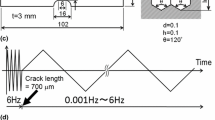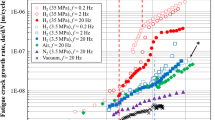Abstract
To investigate the effects of hydrogen on crack propagation in the extremely low growth rate range, fully reversed bending fatigue tests were performed on low carbon steel (JIS S10C) in hydrogen and in nitrogen gas environments at a low pressure. A crack showed almost the same non-propagation behavior in nitrogen as that in air. However, a crack in hydrogen continued to propagate even near \(10^{7}\) cycles in the same testing strain range as that in nitrogen. In hydrogen gas, a crack grew intermittently by coalescing with a new micro-crack generated by slip behavior. This implies that hydrogen could inhibit the action of any factor affecting non-propagation.
















Similar content being viewed by others
References
Aoki Y, Matsuyama T, Oda Y, Noguchi H, Higashida K (2005) Effects of hydrogen gas environment on non-propagation phenomena of a type 304 austenitic stainless steel. Key Eng Mater 297:927–932
Beachem CD (1971) A new model for hydrogen-assisted cracking. Metall Trans 3:437–451
Cameron AD, Smith RA (1981) Upper and lower bounds for the lengths of non-propagating cracks. Int J Fatigue 3:9–15
Chapetti MD, Tagawa T, Miyata T (2003) Ultra-long cycle fatigue of high-strength carbon steels part II: estimation of fatigue limit for failue from internal inclusion. Mater Sci Eng A 356:236–244
Elber W (1971) The significance of fatigue crack closure. In: Damage tolerance in aircraft structure, ASTM STP, vol. 486, pp. 230–242
Elber W (1970) Fatigue crack closure under cyclic tension. Eng Fract Mech 2:37–45
Fenner AJ, Owen NB, Phillips CE (1951) Fatigue crack as stress-raiser. Eng Lond 171:637–638
Frost NE, Dugdale DS (1957) Fatigue tests on notched mild steel plates with measurements of fatigue cracks. J Mech Phys Solids 5:182–192
Frost NE (1960) Correlation of the alternating stresses required to initiate and propagate a fatigue crack in mild steel. Nature 187:233–234
Isibasi T (1951) Strength and deformation of low carbon steel bars with a round-crack under statical and repeated loads. Kyushu University, Mem. Fac. Eng. Kyushu Univ. 12:281–308 (in Japanese)
Kawamoto K, Ochi K, Oda Y, Noguchi H (2009) Effect of hydrogen gas environment on the fatigue strength at 10\(^{7}\) cycles in the plain specimens of type 316L stainless steel. J Sol Mech Mater Eng 3:72–83
Lee D-S, Nishikawa H, Oda Y, Noguchi H (2013a) Small fatigue crack growth characteristics and fracture surface morphology of low carbon steel in hydrogen gas. Int J Fract 179:147–156
Lee D-S, Yamamoto A, Oda Y, Noguchi H (2013b) An investigation of hydrogen environment effect on the strain aging of low carbon steel through Vickers hardness test. J Test Eval 41(1):69–75
Lessells JM, Jacques HE (1950) Effect of fatigue on transition temperature of steel. Weld J 29:74–83
Lipsitt HA, Horne GT (1957) The fatigue behavior of decarburized steel. Proc Am Soc Test Mater 57:587–599
Lipsitt HA, Wang DY (1960) The effects of interstitial solute atoms on the fatigue limit behavior of titanium. Trans AIME 221:918–923
Moriya S, Matsui H, Kimura S (1979) The effect of hydrogen on the mechanical properties of high purity iron I. Softening and hardening of high purity iron by hydrogen charging during tensile deformation. Mater Sci Eng 40:207–216
Murakami Y, Endo T (1980) Effects of small defects on fatigue strength of metals. Int J Fatigue 2:23–30
Murakami Y, Matsuoka S (2010) Effect of hydrogen on fatigue crack growth of metals. Eng Fract Mech 77:1926–1940
Murakami Y, Nomoto T, Ueda T (1999) Factors influencing the mechanism of superlong fatigue failure in steels. Fatigue Fract Eng Mater Struct 22:581–590
Nakagawa T, Ikai Y (1979) Strain aging and the fatigue limit in carbon steel. Fatigue Eng Mater Struct 2:13–21
Nisitani H, Chishiro I (1974) Non-propagating micro-cracks of plain specimens and fatigue notch sensitivity in annealed or heat-treated 0.5 % C steel. Trans Jpn Soc Mech Eng 40:41– 52
Nisitani H, Takao K (1974a) Behavior of a tip of non-propagating fatigue crack during one stress cycle. Eng Fract Mech 6:253–260
Nisitani H, Takao K (1974b) Successive observations of fatigue process in carbon steel, 7:3 brass and Al-alloy by electron microscope. Trans Jpn Soc Mech Eng A 40:3254–3266 (in Japanese)
Oda Y, Noguchi H (2005) Observation of hydrogen effects on fatigue crack growth behavior in an 18Cr-8Ni austenitic stainless steel. Int J Fract 132:99–113
Pineau AG, Pelloux RM (1974) Influence of strain-induced martensitic transformation on fatigue crack growth rates in stainless steels. Metall Trans 5:1103–1112
Ritchie RO, Suresh S, Moss CM (1980) Near threshold crack growth in 2 1/4 Cr\(-\)1 Mo pressure vessel steel in air and hydrogen. J Eng Mater Technol Trans ASME 102:293–299
Sinclair GM (1952) An investigation of the coaxing effect in fatigue of metals. Proc Am Soc Test Mater 52:743–758
Smith RA, Miller KJ (1978) Prediction of fatigue regimes in notched components. Int J Mech Sci 20:201–206
Sofronis P, Birnbaum HK (1993) Mechanics of the hydrogen dislocation impurity intractions-I. Increasing shear modulus. J Mech Phys Solids 43:49–90
Srawley JE (1970) On the sharpness of crack compared with Wells COD. NASA TMS, 52904
Suresh S, Ritchie RO (1983a) Some considerations on the modelling of oxide-induced fatigue crack closure using solutions for a rigid wedge inside a linear elastic crack. Scripta Metall 17:575–580
Suresh S, Ritchie RO (1983b) On the influence of environment on the load ratio dependence of fatigue thresholds in pressure vessel steel. Eng Fract Mech 18:785–800
Tabata T, Birnbaum HK (1984) Direct observations of hydrogen enhanced crack propagation in iron. Scripta Metall 18:231–236
Taira S, Tanaka K, Nakai Y (1978) A model of crack-tip slip band blocked by grain boundary. Mech Res Commun 5:375–381
Tanaka K, Nakai Y (1983) Propagation and non-propagation of short fatigue cracks at a sharp notch. Fatigue Eng Mater Struct 6:315–327
Tzou JL, Suresh S, Ritchie RO (1985a) Fatigue crack propagation in oil environments- I. Crack growth behavior in silicone and paraffin oils. Acta Metall 33:105–116
Tzou JL, Hsueh CH, Evans AG, Ritchie RO (1985b) Fatigue crack propagation in oil environments-II. A model for crack closure induced by viscous fluids. Acta Metall 33:117–127
Uyama H, Nakashima M, Morishige K, Mine Y, Murakami Y (2006) Effects of hydrogen charge on microscopic fatigue behavior of annealed carbon steel. Fatigue Fract Eng Mech 29:1066–1074
Wilcox BA, Huggins RA (1960) Effect of hydrogen on dislocation locking in niobium. J Less-Common Metals 2: 292–303
Yakushiji T, Kage M, Nisitani H (1996) Effect on strain aging on the non-propagation of fatigue crack of low carbon steel. Trans Jpn Soc Mech Eng A 62:82–88 (in Japanese)
Acknowledgments
A part of this study was funded by NEDO and the Japan Society for the Promotion of Science “Grant-in-aid for Scientific Research on JSPS Research Fellowship for Young Scientists”.
Author information
Authors and Affiliations
Corresponding author
Rights and permissions
About this article
Cite this article
Lee, D., Oda, Y. & Noguchi, H. Observation of small fatigue crack growth behavior in the extremely low growth rate region of low carbon steel in a hydrogen gas environment. Int J Fract 183, 223–240 (2013). https://doi.org/10.1007/s10704-013-9889-1
Received:
Accepted:
Published:
Issue Date:
DOI: https://doi.org/10.1007/s10704-013-9889-1




